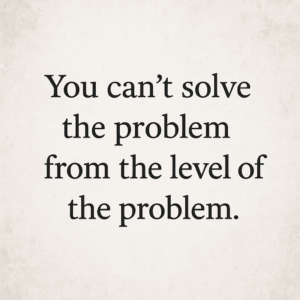Summary Insight:
Your business is a brain. Train it to predict, adapt, and win—or get left behind.
Key Takeaways:
-
Rigid control systems fail in complex markets—neural-inspired adaptability wins.
-
A shared, evolving world model lets your team predict and act faster.
-
Organizational Physics helps you scale like a brain, cutting friction and boosting alignment.
The Brain Is a Prediction Machine.
The brain’s job is to minimize surprise. It constantly updates its beliefs (perception) and takes action (behavior) to align reality with expectation.
For example, when I reach for my morning coffee, my brain predicts: hand grabs cup, cup hits lips, I taste coffee. If I fumble, that’s a negative surprise—the gap between prediction and reality. My brain updates its model, adjusting to avoid future spills.
Learn from it, and you adapt. Focus more. Switch to a better cup. Same mechanism, better outcome.
That’s exactly how a high-performing company should work.
Your Company Is a Brain
Now, imagine your company as a giant brain. Its people, culture, structure, and systems are like neurons, working together to predict, act, and adapt. Your job as a leader is to train this brain to minimize surprises and stay ahead.
How do you do that? There’s a dumb way. And there’s a smart way.
- The Dumb Way: Over-Control
You try to eliminate uncertainty through rules, KPIs, compliance systems, and rigid plans. You pretend the future can be tamed like a spreadsheet.That’s like programming a traditional computer—deterministic, precise, and brittle. Great in theory. Collapses in reality. - The Smart Way: Neural Adaptability
You build your company like a neural network.Neural networks are probabilistic. Adaptive. They embrace ambiguity. They update themselves based on outcomes. They learn. They don’t strive for perfection. They strive to improve their predictive power of the world.
How’s Your World Model?
A world model is your company’s internal simulation of reality. If your organization has a shared, evolving model of itself (people, goals, friction points) and its environment (customers, competitors, trends), it can predict, act, learn, and improve. If you lack that model—or worse, if every department uses a different one—you’re flying blind. You’ll act in conflict with yourself. You’ll react too slowly. You’ll lose.
Start by mapping your current world model. Gather your leadership team and ask: What’s our shared view of our customers, competitors, and internal friction points? If answers differ, you’ve got work to do.
Google’s AlphaZero beats humans at chess, Go, or poker—not just because of speed, but because those games have clear world models: rules, boundaries, feedback loops. Business doesn’t. Markets are murky. Customers evolve. Competitors attack from the side.
That’s why your company needs a neural approach: shared context, fast feedback, real-time learning. A world model that keeps getting better at predicting outcomes and reducing negative surprises.
Because in the end, it’s not the smartest company that wins. It’s the one with the best model of reality.
Designing Your Company Like a Neural Network
Neural networks thrive on interconnection, adaptability, and iterative learning. Here’s how to design your company with these principles, using Organizational Physics as your guide:
- Interconnect Your Teams Like Neurons
Neural networks rely on interconnected nodes that share information rapidly. In your company, this means breaking down silos and creating a structure where teams communicate and collaborate in real time. For example, use Organizational Physics’ Four Quadrant Structure Model to align customer-facing teams (Quadrant 1) with operations (Quadrant 2), innovation (Quadrant 3), and back-office support (Quadrant 4). Each quadrant acts like a neuron, processing inputs (e.g., customer feedback, market trends) and sending outputs (e.g., updated strategies, new products) to others. In a company I advised, we centralized demand generation and e-commerce services (Quadrant 1) to serve four distinct brands, ensuring shared data and insights flowed between teams, much like neural signals. This reduced surprises—like mismatched pricing or misaligned campaigns—and boosted conversions by 15%. - Build Adaptive Feedback Loops
Neural networks learn by adjusting weights based on outcomes—your company should too. Create fast feedback loops to update your world model continuously. For instance, use real-time data (e.g., sales metrics, customer sentiment) to adjust tactics weekly, not quarterly. Organizational Physics emphasizes entropy management—identifying and resolving friction points quickly. Set up cross-functional teams to review predictions versus outcomes, then tweak processes or structures to minimize gaps. A retail client implemented daily sales huddles to spot trends early, catching a 20% drop in demand for a product line and pivoting marketing within a week, avoiding a major loss. - Distribute Decision-Making Like a Neural Network
Centralized control kills adaptability. Neural networks distribute processing across nodes, enabling resilience. Empower teams to make decisions at the edge, guided by a shared world model. Organizational Physics’ principle of “push authority to where the work is getting done” gives teams the autonomy and resources to match the complexity they face. For example, let your sales team adjust pricing within a range to match local market conditions, rather than waiting for HQ approval. A CPG firm I worked with gave regional managers budget autonomy to respond to local competitors cutting response time from 30 days to 3 days and growing market share by 10%. - Train Your Company to Learn Like a Brain
Neural networks improve through training—your company must too. Run experiments, measure outcomes, and scale what works. Treat failures as learning opportunities, not punishments. For instance, test a new customer acquisition channel for one brand, measure ROAS (return on ad spend), and if it exceeds 5:1, roll it out to others. Build a culture where teams share lessons weekly, refining the world model. A healthcare chain tested a new triage system in one clinic, reducing wait times by 30%. They scaled it company-wide, cutting negative surprises (patient complaints) by half. - Scale with Resilience, Not Rigidity
Neural networks are resilient because they adapt weights, not structure. In business, this means scaling with flexible systems, not bureaucracy. Use Organizational Physics to design processes that evolve with your environment—like a brain, not a machine. For example, automate data flows (e.g., CRM to marketing) to reduce manual errors, and create cross-functional roles to handle unexpected disruptions. An e-commerce firm automated pricing adjustments across platforms, maintaining 60% gross margins during a supply chain crisis, while competitors lagged.
When you design your company like a neural network, you create a system that predicts, learns, and adapts in real time. Organizational Physics provides the framework to make this practical, unifying your team around a shared, evolving world model that drives better outcomes.
Why Organizational Physics?
Organizational Physics acts as your company’s neural network blueprint. It’s a foundational world model that aligns your team—like neurons syncing in a brain—so you can predict, adapt, and scale without the baggage of bureaucracy. Built on first principles of physics and systems theory, it cuts through noise—language, culture, personal bias. Anyone in your company, no matter their background, can grasp the core concepts fast.
When you teach and reinforce Organizational Physics, you create a shared world model in your team. The team aligns around shared intentions, anticipates outcomes, reduces negative surprises, and evolves the model to fit your unique environment.
Ready to run your company like a neural network? Start by designing your company’s Key Process Cycles for its product, customer, employee, and strategic execution journeys.




